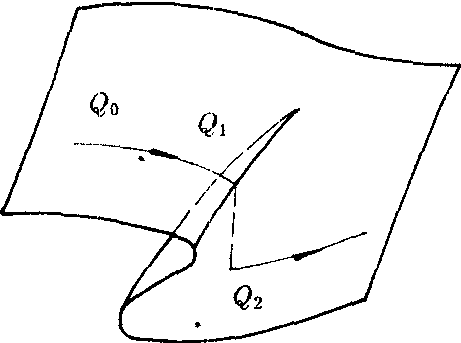突变论tubianlun
一个新的数学分支。法国数学家雷内·托姆在1972年出版的《结构稳定性与形态发生学》一书奠定了该理论的基础。它以拓朴学为基础,从数学的角度研究各种事物在连续变化过程中的突然变化,为突变现象提供了数学模型。它在众多领域得到广泛运用。在物理学中突变论运用于相变、耗散结构的热力学等方面的研究,取得了显著成果。突变论的创始人对把突变论运用于生物学给予重大关注,企图用突变论为形态发生建立数学模型。他认为,生物体的生长可看是一系列渐变为生物化学上的突变所触发,并转而触发生物化学上的突变。根据这一思想,有些科学家已在这方面做出了许多有益的尝试。突变论在医学、化学、地质学、生态学以及社会科学领域也得到广泛应用。
突变论tubianlun
描述突变现象的一般理论。对任何一个系统,其状态的变化可以分为两种类型,一种是连续的渐变,如牛顿力学中常提到的匀加速直线运动,另一种是不连续的、跳跃式的突变,如一定质量的气体在一定的温度和压力之下会变成液体,地壳的剧烈运动引起地震等等。以往我们处理问题的数学工具基本上是以微积分为基础的,系统的状态通常满足一组微分方程,由于微分方程的解必须是可微分的函数,所以它适合于描述连续的渐变的过程,对丰富多彩的突变现象就显得无能为力。60年代末法国数学家托姆(Thom)在当时奇点理论(数学的一个分支)发展的最新成就基础上提出了突变理论,从数学上对各种各样的突变现象进行了分类。突变论强调从整体上把握系统的性质,为研究系统的突变行为提供了新的思路。它处理问题的一般过程如下:❶确定刻划系统宏观状态的变量(x1,x2,…,xn),这些变量应反映系统所表现出来的宏观性质。
❷确定影响系统行为的控制参数(u1,u2,…,ur)。
❸系统的行为受某个依赖于(x1,x2,…,xn;u1,u2,…,ur)的函数P(x1,x2,…,xn;u1,u2,…,ur)所支配,在突变论中,这个函数称为势函数。
❹考察势函数的性质,就能够确定系统突变可能发生的范围。由于现实世界中的突变现象千姿百态。因此一般说来所谓的势函数可以非常复杂。但是托姆突变论的关于基本突变的分类定理指出,对于两个变量的系统尽管势函数P千千万万,但只要势函数中控制参量的个数r(称为余维)不超过4,那么突变方式在某种意义上只有7个基本类型,其它势函数通过变换可以化为这7种形式。下面就是这7种突变类型的名称,控制参量的个数r和一般的势函数的形式。
| 名称 | 余维r (控制 参量个 数) | 函数形式 |
| 折叠型 尖点形 燕尾型 双曲脐点型 椭隧脐点型 蝴蝶型 抛物脐点型 | 1 2 3 3 3 4 4 | x31+u1x1 x41+u1x21+u2x1 x51+u1x31+u2x21+u3x1 x31+x32+u1x1x2+u2x1+u3x2 x31-x1x22+u1(x21+x22)+u2x1+u3x2 x61+u1x41+u2x31+u3x21+u4x1 x21x2+x42+u1x21+u2x22+u3x1+u4x2 |
对于双变量系统只要控制参量的个数不超过4,我们就可以把决定系统状态的势函数化成上面7种类型之一,从而可以决定系统的行为曲面。如尖点型突变,它所对应的行为曲面如下图所示。假定系统的状态在外界参数的控制下从Q0向Q1移动,到达悬崖边缘后,系统的状态就会掉到下半曲面的Q2点上,这也就是系统状态的突变现象。

自从突变论在60年代末问世以来,其应用已遍及自然科学和社会科学各领域。总的来说,突变论的应用分为两类,一类是在力学、物理学等领域中的硬应用。另一类是在生物学、社会科学领域中的软应用,它使得我们可以讨论神经冲动传播、物种的兴衰、经济危机、战争爆发等各种突变行为。但像一切新理论的诞生发展一样,突变论(特别是它的应用)还须在实践中检验。修正与发展。
突变论
研究自然界和人类社会中存在的突变现象的学科。法国数学家托姆1972年发表的专著《结构稳定性和形态发生学》是这一学科建立的标志。突变论把人们关于质变的经验总结成数学模型,力求以统一的数学模型对这些突变加以描述、预测和控制。控制变量和状态变量是突变理论中的两个最基本的概念,前者是指那些作为突变原因的连续变化因素,状态变量是指可能出现突变的量。突变论着重探讨这两个变量之间的关系,用以说明自然界和人类社会中存在的大量不连续现象,如基因突变、地磁场倒转、经济危机、战争与和平等。突变论由于为突变现象提供了数学模型,现已被应用到物理学、生物学、医学、化学、地质学、生态学及社会科学等领域中,并取得了初步成果。